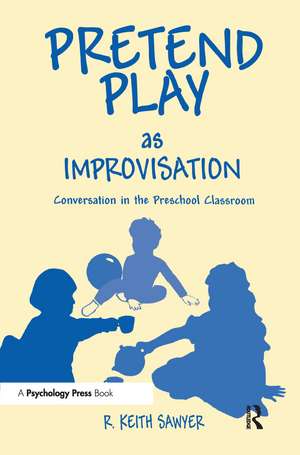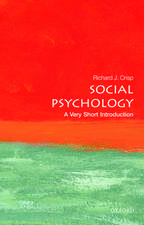Pretend Play As Improvisation: Conversation in the Preschool Classroom
Autor R. Keith Sawyeren Limba Engleză Hardback – 1997
This book adds to our understanding of preschoolers' pretend play by examining it in the context of a theory of improvisational performance genres. This theory, derived from in-depth analyses of the implicit and explicit rules of theatrical improvisation, proves to generalize to pretend play as well. The two genres share several characteristics:
* There is no script; they are created in the moment.
* There are loose outlines of structure which guide the performance.
* They are collective; no one person decides what will happen.
Because group improvisational genres are collective and unscripted, improvisational creativity is a collective social process.
The pretend play literature states that this improvisational behavior is most prevalent during the same years that many other social and cognitive skills are developing. Children between the ages of 3 and 5 begin to develop representations of their own and others' mental states as well as learn to represent and construct narratives. Freudian psychologists and other personality theorists have identified these years as critical in the development of the personality. The author believes that if we can demonstrate that children's improvisational abilities develop during these years--and that their fantasy improvisations become more complex and creative--it might suggest that these social skills are linked to the child's developing ability to improvise with other creative performers.
| Toate formatele și edițiile | Preț | Express |
|---|---|---|
| Paperback (1) | 449.41 lei 6-8 săpt. | |
| Taylor & Francis – 20 ian 2016 | 449.41 lei 6-8 săpt. | |
| Hardback (1) | 999.46 lei 6-8 săpt. | |
| Taylor & Francis – 1997 | 999.46 lei 6-8 săpt. |
Preț: 999.46 lei
Preț vechi: 1218.86 lei
-18% Nou
Puncte Express: 1499
Preț estimativ în valută:
191.30€ • 198.96$ • 160.31£
191.30€ • 198.96$ • 160.31£
Carte tipărită la comandă
Livrare economică 13-27 martie
Preluare comenzi: 021 569.72.76
Specificații
ISBN-13: 9780805821192
ISBN-10: 0805821198
Pagini: 232
Ilustrații: Illustrations
Dimensiuni: 152 x 229 x 20 mm
Greutate: 0.43 kg
Ediția:1
Editura: Taylor & Francis
Colecția Psychology Press
Locul publicării:Oxford, United Kingdom
ISBN-10: 0805821198
Pagini: 232
Ilustrații: Illustrations
Dimensiuni: 152 x 229 x 20 mm
Greutate: 0.43 kg
Ediția:1
Editura: Taylor & Francis
Colecția Psychology Press
Locul publicării:Oxford, United Kingdom
Public țintă
ProfessionalCuprins
Contents: W.A. Corsaro, Foreword. Preface. Introduction: Play as Improvisational Performance. Play and Conversation. An Improvisational Theory of Children's Play. Studying Pretend Play in the Preschool Classroom. Performance Style and Performances. Joining the Performance: The Metapragmatics of Play Entry. The Improvisational Exchange: Using Metapragmatic Strategies to Negotiate the Play Frame. The Performance of Play: Children's Group Improvisations. Improvisation and Development.
Recenzii
"Sawyer's argument is that pretend-play interactions are an opportunity for children to develop the linguistic skills needed to establish a shared intersubjectivity....According to Sawyer, pretend play diminishes as children learn to carry on improvisational conversations....Researchers interested in any of these issues will find this book interesting."
—CHOICE
"Sawyer's clear demonstration of the role of pretence as a training ground for social skills is illuminating, and it is refreshing to have pretence discussed as a topic in its own right and not just as an epiphenomenon of developments in cognitive architecture. The depth and breadth of the book around a narrow focus is impressive."
—British Journal of Developmental Psychology
"Sawyer's contribution is not limited to offering a new conceptualization of pretend play. He brings to our attention a wide collection of important and relevant theories from which play research will benefit in the future. Finally, Sawyer's integration of quantitative and qualitative analyses is a valuable illustration of the improvisation somtimes required from a researcher of children's pretend play."
—Theory and Psychology
—CHOICE
"Sawyer's clear demonstration of the role of pretence as a training ground for social skills is illuminating, and it is refreshing to have pretence discussed as a topic in its own right and not just as an epiphenomenon of developments in cognitive architecture. The depth and breadth of the book around a narrow focus is impressive."
—British Journal of Developmental Psychology
"Sawyer's contribution is not limited to offering a new conceptualization of pretend play. He brings to our attention a wide collection of important and relevant theories from which play research will benefit in the future. Finally, Sawyer's integration of quantitative and qualitative analyses is a valuable illustration of the improvisation somtimes required from a researcher of children's pretend play."
—Theory and Psychology














